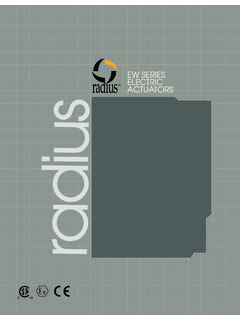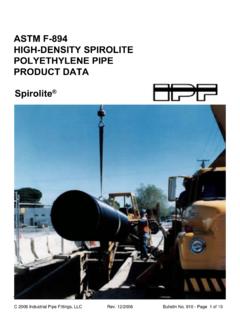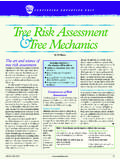Transcription of BEWARE; METAL SURFACES ARE EXCELLENT HEAT …
1 Rev 03 1816 1 radius LLC 4922 Technical Drive Milford, MI 48381 SERIES A OPERATION AND INSTRUCTION MANUAL 1. SPECIAL HAZARDOUS AREAS The Rack & Pinion pneumatic actuators manufactured by radius are designed to be used in the following potential explosive zones: Zone 1 & 2 for gases and Zone 21 & 22 for dust. Low Temperature: II 2GD C T6 / T85 C IP-67 Ta: -85 / +176 F Standard Temperature: II 2GD C T6 / T85 C IP-67 Ta: -4 / +176 F High Temperature: II 2GD C T6 / T85 C IP-67 Ta: -4 / +356 F 2. GENERAL SAFETY PRECAUTIONS. The radius Rack and Pinion Pneumatic Actuators are specifically designed to operate quarter-turn valves, such as Ball, Butterfly and Plug valves. As such they should be: - Used as specified. - Regularly maintained to remain in good working order. - Not be modified without first consulting radius . There are two series of radius rack & pinion air actuators: those with aluminum bodies and those with nodular iron bodies.
2 For a better understanding please refer to the table below. Double action Single action Aluminum actuators series 003 through 500 series 003 through 500 Cast iron actuators series 750 only series 750 only The technical features of the aluminum actuators are listed below. If further information on nodular cast iron is required, please contact radius . BBEEWWAARREE; METAL SURFACES ARE EXCELLENT heat CONDUCTORS. Protect HANDS and EXPOSED SKIN whenever handling ACTUATOR OR ACCESSORIES in extreme temperature environments. BBEEWWAARREE AATT AALLLL TTIIMMEESS; KEEP FINGERS CLEAR OF ALL MOVING PARTS. Rev 03 1816 2 radius LLC 4922 Technical Drive Milford, MI 48381 SERIES A OPERATION AND INSTRUCTION MANUAL DESCRIPTION radius actuators are quarter turn actuators; that is to say that the actuator shaft turns 90 , although some models can be ordered with turning angles of up to 180.
3 The design of these actuators uses the system of a double rack single pinion. One of the most outstanding features of radius actuators, available only with the aluminum models, is its proprietary, revolutionary double travel stop system. This system allows a complete regulation of the opening and closing of the aperture without having to remove the covers. The standard units produce a torque between 132 and 52,660 lb. in. at 80 psi that, together with the shaft s output range and its modular design, allows the attachment of a wide variety of control accessories. ACTUATOR DESIGNATION The actuators are designated as follows: AD-xxx Double Acting Actuators AS-xxx Single Acting Actuators xxx Designates actuator size. GENERAL DATA Interface for positioner or signal transmitters dimensions in accordance with: VDI/VDE-3845 Valve connection flange according to: ISO-5211 Solenoid valve interface: DIN228/1 Working pressure: 15 - 120 PSI Double Acting Actuators 40 - 120 PSI Single Acting Actuators.
4 Medium: Air or non-corrosive gas. Working temperature: Low Temp -85 F to +176 F / Standard Temp. -4 F to +176 F / High Temperature -4 F to +356 F Travel stop adjustment: 0 2,5 to 90 2,5 ATTACHMENT OF THE ACTUATOR The radius actuators can be installed directly or by using an adapter on the shaft of any valve. They have a female coupling machined directly on the shaft that meets DIN-3337 and ISO-5211 standards. radius also offers a complete range of accessories to complement any coupling concept. Rev 03 1816 3 radius LLC 4922 Technical Drive Milford, MI 48381 SERIES A OPERATION AND INSTRUCTION MANUAL INSTALLATION OF THE ACTUATOR The radius actuators are normally installed so that their longitudinal axis is parallel to the direction of the pipeline. The actuators can be installed on top, on the side or underneath the valve they are to attach to without affecting their operation in anyway.
5 The actuator output shaft is completely machined and in the shape of an eight pointed star, following DIN-3337 and ISO-5211 standards, which allows the actuator to be oriented in a way that can adapt to nearly every installation. The necessary steps for the proper installation of an actuator onto a valve are the following: a. Determine the valve s type of operation. b. Determine the quadrant and the direction in which the actuator will be installed ( , perpendicular or parallel to the fluid line.) c. The connection of the assembly, support/actuator/valve, must be done in the following manner: 1. Rotate the actuator shaft to the desired position. 2. Install the valve support. At this time, the bolts must not be completely tightened. 3. Place the coupling on the valve shaft, making sure that it is correctly placed. 4. Set the actuator on the valve, making sure that the coupling is correctly inserted in the actuator shaft.
6 5. Secure the support to the valve using the proper bolts and tighten all the bolts. 6. At this point, check that the actuator and the valve are in the desired position. 7. In the event that it is not correctly positioned, remove the actuator and repeat all the steps. WARNING: NEVER REMOVE A PRESSURIZED ACTUATOR! FEATURES AND OPERATING PRINCIPLES 1. Basic Actuator The radius actuator shaft rotates a full 90 (some models can be ordered with a 180 rotation angle). The opening rotation is achieved, both in the double and single action models, by supplying air pressure into the piston chambers. This thereby forces them to move in opposite directions and separating them one from the other, resulting in a counterclockwise rotation of the shaft. At the end of the travel the actuator Rev 03 1816 4 radius LLC 4922 Technical Drive Milford, MI 48381 SERIES A OPERATION AND INSTRUCTION MANUAL will be in the open position.
7 In the double action actuators, the closing movement is obtained by supplying air pressure to the chambers in both covers, forcing the pistons to move in opposite directions. This causes the pistons to draw nearer to each other. Consequently, the shaft rotates clockwise obtaining the closed position at the end of the travel. Closing of the single action actuators is obtained by the force the springs in the chambers of the covers exercise on the pistons, forcing them to move in opposite directions drawing them together, achieving the same result as in the double action actuators. If a change in the direction of rotation is required, it is sufficient to rotate the pistons 180 . 2. Manual Operation In the event of an air supply failure, the radius actuators can be operated manually. This can be done using an adjustable wrench on the upper part of the actuator shaft, turning it in the desired direction.
8 radius also offers a varied range of declutchable gear operators for this operation. For more information consult radius . WARNING: MAKE SURE THAT THE ACTUATOR IS NOT OPERATING AUTOMATICALLY WHEN A MANUAL OPERATION IS BEING PERFORMED. NOTE: A PROPER RELEASE OF AIR IS REQUIRED FOR MANUAL OPERATION. THIS REQUIRES THE DISCONNECTION OF THE AIR LINES OR THE USE OF THREE WAY VALVES AT THE AIR PORTS. Rev 03 1816 5 radius LLC 4922 Technical Drive Milford, MI 48381 SERIES A OPERATION AND INSTRUCTION MANUAL STANDARD ACTUATION TIMES The normal actuation times for radius actuators are shown in the following table. The times are in seconds and they represent an average of the times in a non-load condition at a pressure of 80 psi. The times shown are for double and single action actuators. The closure times for the single action actuators depend on the number of springs used.
9 The following is a table of times; the values are simply a guide and should be used as an indication of the speed that may be obtained. MODEL INTERNAL AIR VOLUME (in ) ACTUATION TIME (SEC.) DOUBLE ACTION SINGLE ACTION OPENING CLOSING OPENING CLOSING AD/AS-003 <1 <1 1 AD/AS-005 <1 <1 1 AD/AS-008 <1 <1 1 AD/AS-012 <1 <1 1 - 2 AD/AS-020 <1 <1 1 - 2 AD/AS-030 1 - 2 1 2 2 - 3 AD/AS-040 1 - 2 1 2 2 - 4 AD/AS-060 2 - 4 2 4 3 - 6 AD/AS-100 3 - 5 3 5 5 - 8 AD/AS-200 5 - 8 5 8 8 - 11 AD/AS-250 6 - 8 6 8 10 - 14 AD/AS-370 7 - 9 11 14 17 - 20 AIR SUPPLY AND ELECTRICAL INSTALLATION A) AIR SUPPLY radius actuators are correctly lubricated at the factory. All lubricants are silicone free. The use of dry, clean, air or gas is recommended for optimal operation. Although lubrication of the media is not essential, it is recommended.
10 B) AIR PRESSURE SUPPLY The standard double action actuator version requires 15 to 120 psi air pressure. The single action actuators require between 40 to 120 psi air pressure. C) AIR SUPPLY CONNECTIONS - Without an electrically-operated valve Rev 03 1816 6 radius LLC 4922 Technical Drive Milford, MI 48381 SERIES A OPERATION AND INSTRUCTION MANUAL 1) Double Action (AD Models) First, the dust cover plugs from the air intake ports must be removed. After the plugs are removed, the air supply lines must be connected to the two inlet ports that are located on the side of the actuator body: Standard units operate in the following manner: Port A: Counterclockwise rotation / opening the actuator. Port B: Clockwise rotation / closing the actuator. 1) Single action (AS Models) As in the double action actuators, the dust cover plugs must be removed first; then, the air supply line must be connected to Port A.









